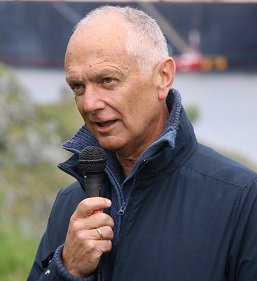Faglige interesser
Gjennom årene har jeg skrevet om arkeologiske emner som spenner i tid fra bronsealder til 1600-tallet, men det meste av min produksjon dekker perioden 200-1150 e.Kr. Jeg har for det meste arbeidet med bosetningshistorie, økonomi, urbanisering, eiendomshistorie, sosiale og politiske strukturer, kristning og den tidlige kirkeorganisasjonen. Frem til omkring 2011 har min forskning sprunget ut av utgravningene i vikingbyen Kaupang 2000-2003.
Siden har jeg for det meste arbeidet med problemstillinger som knytter seg til det forskningsprosjektet jeg har ledet siden 2006, Kongsgårdprosjektet Avaldsnes. Det tar utgangspunkt i Avaldsnes på Karmøy, som var kongsgård i middelalderen, trolig også i slutten av vikingtiden. Prosjektet gjennomførte I 2011-12 utgravninger av jernalderens og vikingtidens bosetning på Avaldsnes. Det ble da oppdaget ruinene av et kongsgårdsanlegg fra omkring 1300, som vi gravde ut i 2017. Den første boken fra prosjektet kom i 2018, den andre og siste kommer i 2019. Forskningen i prosjektet fortsetter frem til 2024, og hovedvekten kommer til å ligge på utviklingen av de skandinaviske kongedømmer gjennom det første årtusen e. Kr. Kongedømmenes historie skal skrives inn i historien om de kontinentale germanske kongedømmene som vokste frem fra 200-tallet og fremover.
Bakgrunn
Utdannelse
- 2007-08 Forskningslederprogrammet ved Universitetet i Oslo
- 1999 Kurs i universitetspedagogikk ved UiO. Oppnådd universitetspedagogisk basiskompetanse
- 1997 Doctor philosophiæ på avhandlingen Herredømmet. Bosetning og besittelse på Romerike 200-1350 e. Kr.
- 1984 Magistergrad i Nordisk Arkeologi ved Universitetet i Oslo på avhandlingen Gård og kirke, bygd og sogn. Organiseringsmodeller og organiseringsenheter i middelalderens kirkebygging i Sør-Gudbrandsdalen. Støttefag sosialantropologi og etnologi
Ansettelser
- 2010→ Professor i jernalder og vikingtid ved Kulturhistorisk Museum, Universitetet i Oslo
- 1996-2010 Professor i historisk arkeologi ved IAKN/IAKK/IAKH, Universitetet i Oslo. Frem til 2001 Førsteamanuensis
- 1992-96 Universitetsstipendiat, Universitetet i Oslo
- 1975-92 Diverse ansettelser i utgravningsprosjekter (vesentlig kirker og byer), saksbehandler hos Riksantikvaren, samt fylkesarkeolog i Akerhus
Priser
Formidlingsprisen 2000 fra det Historisk-filosofiske fakultet, UiO
Verv
- Siden 2015: Member of the International Science Council of the Leiden Faculty of Archaeology
- Siden 2014: Medlem av Det Norske Vitenskapsakademi
- Siden 2013: Medlem av Det Kongelige Norske Videnskabers Selskab
- Siden 2012: Medlem av Kungl. Gustav Adolfs Akademien för svensk folkkultur
- Siden 2011: Medlem av Det Kongelige Danske Videnskabernes Selskab
- Siden 2011: Member of an international review panel of the Danish Council for Independent Research, Humanities
- Siden 2010: Leder for SFF-prosjektet ved Kulturhistorisk museum: Centre for Viking-Age Studies
- Siden 2010: Korrespondierenden Mitglied des Deutschen Archäologischen Instituts, ”damit Ihr ertragreichen Forschungen zur Ur- und Frühgeschichte und Ihr Engagement für die Zusammenarbeit in unserem Fach”.
- Siden 2010: Medlem av Advisory Board til Center for Medieval Studies, Amterdam University
- Siden 2010: Medlem av styringsgruppen for prosjektet ”Førkristne kultpladser” ved Nationalmuseet, København
- Siden 2010: ’Member of the Editorial Board’ i Acta Scandinavica, skrifttserie utgitt av Brepols i samarbeid med The Centre for Scandinavian Studies at the University of Aberdeen
- Siden 2007: Medlem av ’ESF Pool of Reviewers’
- Siden 2007: Prosjektleder for ”Forprosjekt Avaldsnes”, fra 2010 ”Kongsgårdprosjektet Avaldsnes”
- Siden 2005: Én av to norske ‘National Representatives in The Viking Congress Council'
Samarbeid
Jeg har hatt et omfattende nasjonalt og internasjonalt samarbeid i tilknytning til de forskningsprosjekter jeg har ledet og leder: Kaupang-undersøkelsen, Kongsgårdprosjektet Avaldsnes og Centre for Viking-Age Studies.

 orcid.org/0000-0003-4869-0189
orcid.org/0000-0003-4869-0189